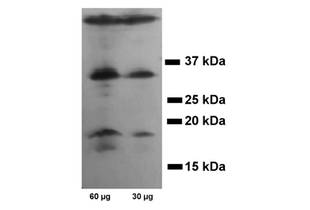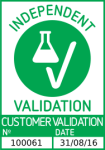Caspase 3 anticorps
-
- Antigène Voir toutes Caspase 3 (CASP3) Anticorps
- Caspase 3 (CASP3)
-
Reactivité
- Humain, Souris, Rat
-
Hôte
- Souris
-
Clonalité
- Monoclonal
-
Conjugué
- Cet anticorp Caspase 3 est non-conjugé
-
Application
- Western Blotting (WB), Immunohistochemistry (IHC)
- Specificité
- The antibody detects endogenous Active Caspase-3 protein.
- Attributs du produit
- Mouse Monoclonal to Active Caspase-3.
- Purification
- The antibody was affinity-purified from mouse ascites by affinity-chromatography using epitope-specific immunogen.
- Immunogène
- Recombinant Protein
- Clone
- 5E1
- Isotype
- IgG1
- Top Product
- Discover our top product CASP3 Anticorps primaire
-
-
- Indications d'application
- WB 1:500-1000, IHC 1:100-200
- Restrictions
- For Research Use only
-
- by
- Laboratory of Neurobiology, Department of Veterinary Sciences, University of Turin
- No.
- #100061
- Date
- 31.08.2016
- Antigène
- Caspase 3 (active)
- Numéro du lot
- Application validée
- Western Blotting
- Contrôle positif
- Mouse cerebellar tissue samples at post natal day P5
- Contrôle négative
- Conclusion
- The antibody recognized both the active and non-active form of Caspase3 and worked well in the experimental conditions tested. The product is therefore indicated for the WB use.
- Anticorps primaire
- Anticorps secondaire
- ABIN3179097
- Full Protocol
- Mouse cerebellar tissue samples at post natal day (P) 5 were lysed in 150 µL of lysis buffer.
- Protein concentration was determined using Bradford reagen (Sigma B6916) according to the manufacturer's recommendation.
- 30 and 60µg total protein were denatured in sample buffer for 5min at 95°C and then cooled on ice.
- Proteins were separated on a denaturing homemade 15% SDS-PAGE gel at a constant voltage of 180V for 70min.
- Proteins were transferred in a transfer buffer to nitrocellulose membrane (Amersham Biosciences, RPN203D, lot 18100/66/0207) at constant amperage of 400mA for 60min.
- Blocking of the membrane with blocking solution (0.01M PBS, 0.1% tween, 2% Bovine Serum Albumin) for 1h at RT.
- Incubation with the primary antibody ABIN3179097 diluted 1:1000 in blocking solution ON at 4°C.
- 3 washes in PBS-0.1% tween for 15min at RT.
- Incubation with the anti-mouse horseradish peroxidase (HRP) secondary antibody (Santa Cruz, SC2005, lot H0406) diluted 1:10000 in blocking solution for 1h at RT.
- Washes in PBS-0.1% tween for 15min at RT.
- Chemiluminescence detection using homemade ECL (1min incubation at RT) and revealed on HYPERFILM EGL (Amersham Biosciences, RPN2013K, lot 04450300115); exposure 30sec.
- Proteins were revealed using the ECL technique on western blot films for 30 seconds.
- Notes
- A band around 30-35 kDa and a band around 17kDa were detected with the experimental procedures previously described.
- A protein load of 30µg is recommended, as in the 60µg load, weak non-specific bands were detected around 15 and 30kDa.
Validation #100061 (Western Blotting)![Testé avec succès 'Independent Validation' signe]()
![Testé avec succès 'Independent Validation' signe]() Validation ImagesProtocole
Validation ImagesProtocole -
- Format
- Liquid
- Buffer
- Liquid in PBS containing 50 % glycerol, 0.5 % BSA and 0.02 % sodium azide.
- Agent conservateur
- Sodium azide
- Précaution d'utilisation
- This product contains Sodium azide: a POISONOUS AND HAZARDOUS SUBSTANCE which should be handled by trained staff only.
- Conseil sur la manipulation
- Avoid repeated freeze/thaw cycles.
- Stock
- -20 °C
- Stockage commentaire
- Store at -20°C.
-
-
: "Alpha-1-Antitrypsin Protects Vascular Grafts of Brain-Dead Rats Against Ischemia/Reperfusion Injury." dans: The Journal of surgical research, Vol. 283, pp. 953-964, (2023) (PubMed).
-
: "Alpha-1-Antitrypsin Protects Vascular Grafts of Brain-Dead Rats Against Ischemia/Reperfusion Injury." dans: The Journal of surgical research, Vol. 283, pp. 953-964, (2023) (PubMed).
-
- Antigène
- Caspase 3 (CASP3)
- Autre désignation
- Caspase-3 (CASP3 Produits)
- Synonymes
- anticorps CPP32, anticorps CPP32B, anticorps SCA-1, anticorps A830040C14Rik, anticorps AC-3, anticorps Apopain, anticorps CC3, anticorps Caspase-3, anticorps Lice, anticorps Yama, anticorps mldy, anticorps xcpp32, anticorps casp3, anticorps zgc:100890, anticorps CASP-3, anticorps caspase-3, anticorps caspase 3, anticorps caspase 3 S homeolog, anticorps caspase 3, apoptosis-related cysteine peptidase a, anticorps caspase 3, apoptosis-related cysteine peptidase, anticorps CASP3, anticorps Casp3, anticorps casp3.S, anticorps casp3a
- ID gène
- 836
- UniProt
- P42574
- Pathways
- Apoptose, Caspase Cascade in Apoptosis, Sensory Perception of Sound, ER-Nucleus Signaling, Positive Regulation of Endopeptidase Activity, Activated T Cell Proliferation
-


 (1 reference)
(1 reference) (1 validation)
(1 validation)



